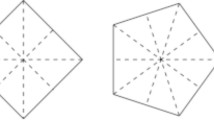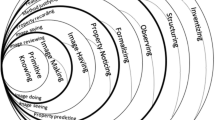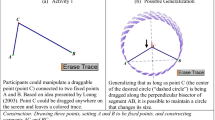Abstract
In this exploratory empirical study, we use a relatively new teacher education apparatus that consists of developing MERLO tasks, which provides fertile ground for teachers to engage in secondary-level mathematical concept study. Within the domain of geometry, we illustrate how this apparatus can help to clarify certain important concepts, specifically in relation to the coordination of visual and linguistic registers, which is at the heart of geometric reasoning. We also discuss the possibility of using this approach as a means of exploring another mathematical register: the dynamic register.
Résumé
Dans cette recherche empirique exploratoire, nous avons recours à un dispositif de formation assez récent qui consiste à concevoir des tâches (MERLO), ce qui offre un contexte propice pour que les enseignants puissent décortiquer des concepts mathématiques du secondaire. En ciblant le domaine de la géométrie, nous montrons quelques enjeux importants que ce dispositif peut éclairer, surtout par rapport à la coordination des registres visuel et langagier, ce qui est au cœur du raisonnement géométrique. Nous discutons aussi de la possibilité d’avoir recours à ce dispositif comme occasion d’explorer un autre registre: le registre dynamique.










Similar content being viewed by others
Notes
Veuillez noter que les figures et extraits ont été traduits de l’anglais.
Bien qu’Emma ait conçu cette tâche à l’aide du logiciel GSP, elle l’a transférée en fichier Word, rendant ainsi statiques tous les énoncés. Nous n’avons donc pas créé de version dynamique pour cette tâche.
Nous soulignons que les angles dans les cases a, b, c et e ne sont pas codés comme étant isométriques, alors ils jouent un rôle déictique. En revanche, les segments dans les cases b et c sont codés comme étant parallèles. Nous soulignons que les cases a, b, c et e sont des représentations dans le registre visuel. Puisqu’il n’y a aucun recours au registre dynamique, nous n’avons pas créé de version WebSketchpad de cette tâche MERLO.
Références
Arzarello, F., Robutti, O. et Carante P., (2015). MERLO: A new tool and a new challenge in mathematics teaching and learning. Dans K. Beswick, T. Muir et J. Wells (dir.), Proceedings of the 39th Conference of the International Group for the Psychology of Mathematics Education, (Vol. 2, pp. 57–64). Hobart, Australia: PME.
Bednarz, N. (2001). Didactique des mathématiques et formation des enseignants: Le cas de l’Université du Québec à Montréal, Revue canadienne de l’enseignement des sciences, des mathématiques et de la technologie, 1(1), 61–80.
Carante, P. (2017). MERLO items as educational tools for mathematics teachers professional development. Thèse de doctorat inédite. University of Turin, Italy.
Carante, P. et Robutti, O. (2016). MERLO items for exploring and discussing about mathematical meanings. Presentation 13th International Congress on Mathematical Education (ICME-13). Hamburg, 24–31 July 2016.
Davis, B. et Renert, M. (2014). The math teachers know: profound understanding of emergent mathematics. New York: Routledge.
Duval, R. (1983). L’obstacle du dédoublement des objets mathématiques. Educational Studies in Mathematics, 14, 385–414.
Duval, R. (1993). Registres de représentation sémiotique et fonctionnement cognitif de la pensée. Annales de didactique et de sciences cognitives, 5, 37–65.
Duval, R. (2005). Les conditions cognitives de l’apprentissage de la géométrie: développement de la visualisation, différenciation des raisonnements et coordination de leurs fonctionnements. Annales de didactique et de sciences cognitives, 10, 5–53.
Duval, R. (2006). A cognitive analysis of problems of comprehension in a learning of mathematics. Educational Studies in Mathematics, 61, 103–131.
Etkind, M., Kenett, R. S. et Shafrir, U. (2010). The evidence-based management of learning: Diagnosis and development of conceptual thinking with meaning equivalence reusable learning objects (MERLO). Dans C. Reading (dir.), Data and context in statistics education: Towards an evidence-based society. Proceedings of the Eighth International Conference on Teaching Statistics (ICOTS8), Ljubljana, Slovénie. Voorburg, The Netherlands: International Statistical Institute.
Etkind, M., Prodromou, T. et Shafrir, U. (2018). Enhancing learning outcomes with ‘big data’ from pedagogy for conceptual thinking with meaning equivalence reusable learning objects (MERLO) and interactive concept discovery (InCoD). Dans M. A. Sorto, A. White, et L. Guyot (dir.), Looking back, looking forward. Proceedings of the Tenth International Conference on Teaching Statistics (ICOTS10), Kyoto, Japon. Voorburg, The Netherlands: International Statistical Institute.
Etkind, M. et Shafrir, U. (2013). Teaching and Learning in the Digital Age with Pedagogy for Conceptual Thinking and Peer Cooperation. Dans Proceedings of the 7th International Technology, Education and Development Conference (INTED) (pp. 5342–5352). Valencia, Spain.
Goldenberg, P., et Cuoco, A. (1998). What is dynamic geometry? Dans R. Lehrer et D. Chazan (dir.), Designing learning environments for developing understanding of geometry and space. Mahwah, NJ: Erlbaum.
Healy, L. (2000). Identifying and explaining geometrical relationship: interactions with robust and soft Cabri constructions. Dans T. Nakahara and M. Koyama (dir.), Proceedings of the 24th Conference of the International Group for the Psychology of Mathematics Education, (Vol. 1, pp. 103–117). Hiroshima: Hiroshima University.
Herscovics, N. et Bergeron, J. (1982). La formation des enseignants à l’analyse conceptuelle en didactique de la mathématique. Revue des sciences de l’éducation, 8(2), 293–311.
Lajoie, C. et Thibault, M. (2017). La mise à contribution de la didactique des mathématiques dans l’enseignement et la recherche. Dans S. El Euch, A. Groleau et G. Samson (dir.), Didactiques, (pp. 35–54). Presses de l’Université du Québec.
Robutti, O., Arzarello, F., Carante, P., Kenett, R., Prodromou, T., & Shafrir, U. (2016). Meaning Equivalence: a methodological tool for assessing deep understanding. Proceedings of the International Technology, Education and Development Conference (INTED 2016), Valencia, Spain.
Shafrir, O. et Kenett, R. S. (2016) Concept science evidence-based MERLO learning analytics. Dans E. Railean, G. Walker, A. Elçi et L. Jackson (dir.), Handbook of Research on Applied Learning Theory and Design in Modern Education, (pp. 334–357) Hershey, PA: Advances in Educational Technologies and Instructional Design.
Sinclair, N., Cirillo, M. et de Villiers, M. (2017). The teaching and learning of geometry. Dans J. Cai (dir.), Compendium for Research in Mathematics Education. Reston, VA: National Council of Teachers of Mathematics.
Sinclair, N., et Yurita, V. (2008). To be or to become: How dynamic geometry changes discourse. Research in Mathematics Education, 10(2), 135–150.
Author information
Authors and Affiliations
Corresponding author
Ethics declarations
Conflit d'intérêt
Les auteurs déclarent qu’ils n’ont pas de conflit d’intérêts.
Additional information
Remarques de l'éditeur
Springer Nature reste neutre quant aux revendications juridictionnelles relatives aux cartes publiées et à l'appartenance institutionnelle.
Rights and permissions
About this article
Cite this article
Thibault, M., Sinclair, N. Conception de tâches MERLO: un dispositif dans la formation continue pour l’enseignement de la géométrie. Can. J. Sci. Math. Techn. Educ. 19, 189–203 (2019). https://doi.org/10.1007/s42330-018-0036-x
Published:
Issue Date:
DOI: https://doi.org/10.1007/s42330-018-0036-x




